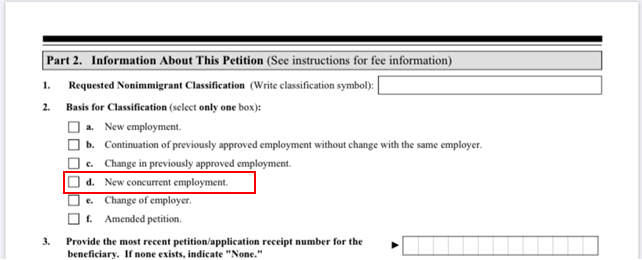
Working for Multiple H-1B Employers Possible Through Concurrent H-1B Employment
The COVID-19 pandemic has forced employers and employees to quickly adjust work arrangements to ensure business continues seamlessly. Many employers have implemented remote work arrangements and, in some cases, adjusted employee work hours and pay. Adjusted work arrangements and reduced pay have left some H-1B workers wondering whether they can work for multiple H-1B employers at the same time. The answer is yes, through what is known as Concurrent H-1B employment.
-
How does Concurrent H-1B employment work?
If an individual is in valid H-1B status with company A, company B can file for Concurrent H-1B employment. Company B must obtain a certified Labor Condition Application (LCA) from the Department of Labor and file its own separate H-1B petition with USCIS. Company B would check, “New concurrent employment” on Form I-129 as shown below.
Under H-1B portability rules, the H-1B worker may begin work with the Concurrent H-1B employer as soon as the H-1B petition is received by USCIS. If for any reason the H-1B petition for concurrent employment is denied, the H-1B worker would be required to stop working for company B, but may continue working for company A.

-
What are the requirements for Concurrent H-1B employment?
The requirements are no different than any other H-1B petition. For example, company B is still required to establish that a bona-fide employer-employee relationship exists, all prevailing wage requirements are met, and the position is a specialty occupation, requiring at least a Bachelor’s degree in a field related to the position. The H-1B worker must also qualify to accept the job offer in the specialty occupation by:
- Demonstrating completion of a U.S. bachelor’s or higher degree required by the specific specialty occupation from an accredited college or university;
- Holding a foreign degree that is the equivalent to a U.S. bachelor’s or higher degree in the specialty occupation; or
- Having education, training, or progressively responsible experience in the specialty that is equivalent to the completion of such a degree.
When required, the H-1B worker must provide an unrestricted state license, registration, or certification, authorizing the worker to fully practice the specialty occupation.
-
How many employers can an H-1B worker work for through concurrent employment?
Although there is no set limit on how many H-1B employers an individual can work for, the H-1B worker will still be required to maintain H-1B status throughout employment. Therefore, H-1B workers must be realistic regarding how many hours per week they are required to work for each H-1B employer.
-
Can an H-1B worker work full-time for 2 H-1B employers through concurrent employment?
There is not a maximum number of hours an H-1B holder can work. Therefore, an H-1B worker can technically have 2 full-time positions under concurrent employment. Note, it is possible that USCIS will deny the concurrent H-1B petition for full-time employment if it does not appear possible to work 2 full-time jobs (A full-time week is 40 hours per week, unless the employer can demonstrate that less than 40 hours per week is full-time employment in its regular course of business. In no event would less than 35 hours per week be considered to be full-time employment).
Therefore, where an H-1B holder is working full-time with company A, it may be more prudent for company B to file for concurrent part-time employment.
-
Can an H-1B worker work part-time for 2 H-1B employers through concurrent employment?
Yes, an H-1B worker can hold 2 part-time positions under H-1B concurrent employment. Anything less than 35 hours per week is considered part-time employment.
-
Can an H-1B worker work remotely for multiple H-1B employers?
Yes, an H-1B worker can work remotely for multiple H-1B employers as long as an LCA and H-1B petition are properly filed to include the remote work location and all LCA posting requirements are met.
-
Can an H-1B petition for concurrent employment be filed if an initial H-1B petition was selected in the lottery?
An H-1B petition for concurrent employment can be filed once the initial H-1B petition with company A is approved and the individual is in valid H-1B status (beginning no earlier than October 1st).
Each situation is different and requires careful legal analysis to ensure the best outcome for your case. If you are an H-1B worker who is contemplating concurrent H-1B employment and have questions, you can schedule a consultation with any of our qualified immigration attorneys at https://appointments.rnlawgroup.com/.
Krystal Alanis is a Partner at Reddy Neumann Brown PC She acts as the Managing Attorney for the firm’s PERM Labor Certification Department, where she oversees all EB-2 and EB-3 employment based green card matters. She also guides employers and individuals through the I-140 and Adjustment of Status process, assists clients with non-immigrant visa petitions (e.g. H-1B, TN, L-1, etc.), and advises her clients on I-9 compliance issues.

